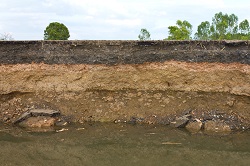New weathering analysis accurately traces the geochemical flux beneath the Earth’s surface
Harnessing natural resources at the Earth’s surface is taking place at an unprecedented pace and scale. If this exploitation of soil, water, and precious metals is to be sustainable, it has to become more efficient. Achieving this rests on better understanding of the transformative biogeochemical processes involved when chemical elements travel from rock to soil, into plants, through ground water, into river water and into ore deposits. The EU-funded IsoNose project was established to use recent technological advances, especially within the field of mass-spectrometry, to explore the formation of these natural resources and so open the field for better practices. The project shed further light, not only on the way the Earth’s surface transfers dissolved chemical elements but also on how metals shift their isotope fingerprint, as they are taken up by organisms. Measuring isotopes with mass spectrometry Rock is converted into soil, (weathering), when water flows through rock fractures and the ensuing chemical reactions convert primary minerals into secondary minerals, with organic carbon accumulating near the Earth’s surface and a soil layer left below. This process typically plays out over thousands of years. Rock dissolution results in each of the chemical elements which had been trapped, such as magnesium, iron or zinc (taking metallic examples), following different pathways. Some travel into the newly formed soils, others are consumed by plants, with some dissolved into rivers. To learn more about the composition and transformation of metallic elements specifically, the IsoNose team collected host rock, weathered soil and sediment, as well as water samples, for lab analysis. Analysis depended on measuring the isotopes of these elements (their varying atomic weight or mass) in the samples. The researchers made use of so-called ‘isotope fractionation’ - the preference of certain isotopes (with heavier or lighter atomic weights) to move into a given material that formed at the Earth’s surface by weathering, for example. This then hints at the likely causes of these transformations (such as climate change). The team first weighed the samples to determine how much of each element they contained, with a process called chromatography then employed to separate the elements from each other. A mass spectrometer was then used to measure the isotopes by injecting the ionised isotope particles into a tube with an electric field, separating the lighter isotopes from the heavier ones, giving each sample an isotope ratio value. As project coordinator Professor Friedhelm von Blanckenburg, elaborates, “Combining this existing method of ‘multicollector inductively-coupled mass spectrometry’ with a technique called femtosecond laser ablation turned out to be extremely powerful. The combination measured very precisely and simultaneously tiny shifts in the relative abundance of metallic element isotopes and chemical amounts on solids with a resolution of a few thousandths of a millimetre.” Towards improved practices and expanded scope From an environmental perspective, IsoNose’s research can be used to explain how the Earth’s surface has regulated climate and greenhouse gases, over millions of years. The techniques can also be deployed to identify sources of environmental contaminants, as well as to determine the effectiveness of remediation efforts. Measuring metallic isotopes also increases understanding about how these elements came to be within rock in the first place, offering the mining industry insights for more sustainable extraction. As Professor von Blanckenburg puts it, “We have provided a scientific framework, with empirical data, for the better use of the Earth’s surface resources in a manner which will not impair use by future generations.” Another likely area of future research is to transfer these techniques to soil management practices, for food production which can more effectively meet the needs of a global population, now well in excess of 7 billion people and fast growing. Measuring metallic isotopes could help accurately track the pathways of mineral nutrients from soils to plants and so lead to more targeted fertilisers, as well as the establishment of biomarkers for diseases. Concluding, Professor von Blanckenburg says, “Our researchers will use IsoNose as a platform from which to lead this emerging field into new areas including the geosciences, environmental forensics, biomedical sciences and mineral resource prospecting.”
Keywords
IsoNose, soil, rock, weathering, water, minerals, metallic elements, isotopes, ore deposits, mass spectrometer, food production



